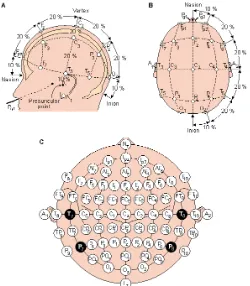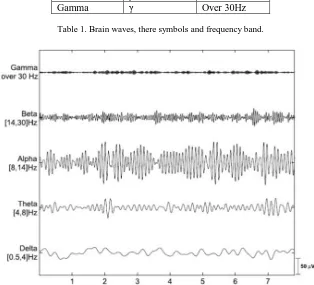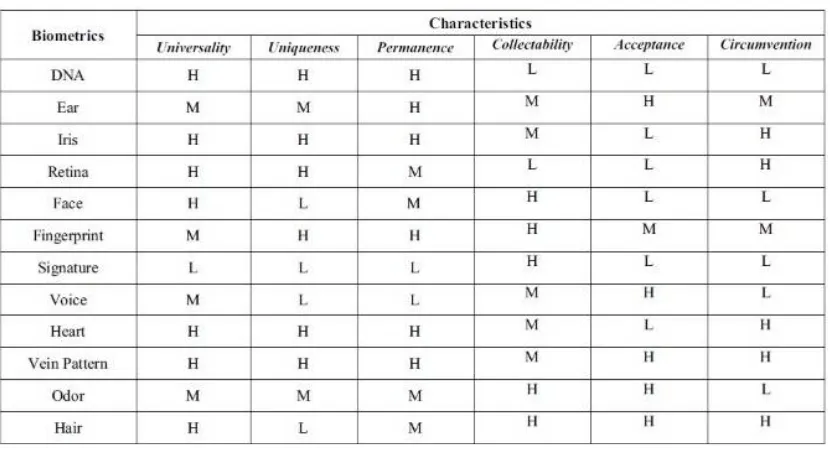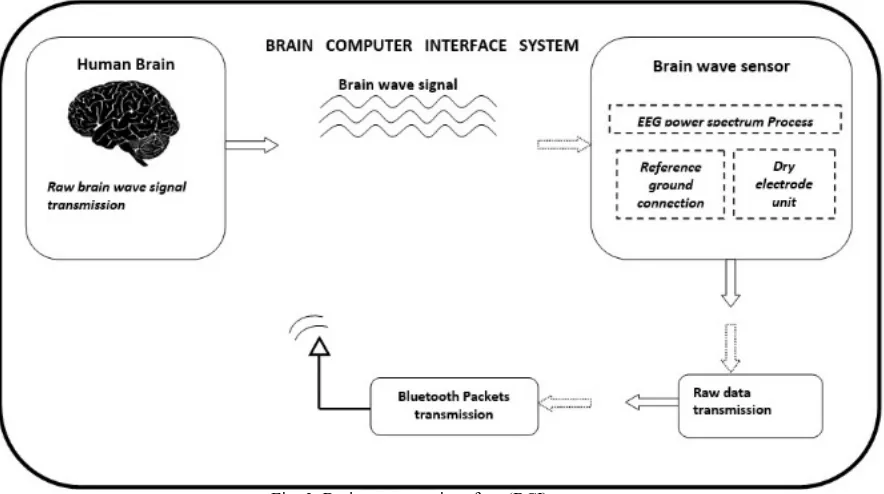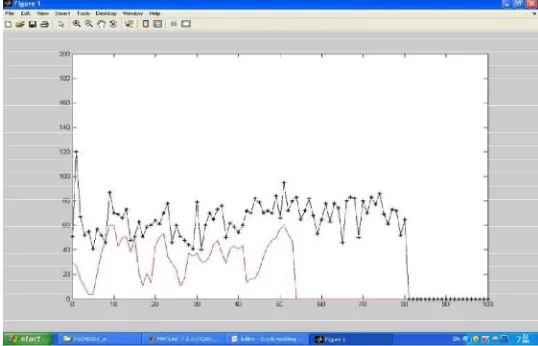Wireless Recording of Brain Waves and
Biometric User Authentication
Yashraj S. Soni1, S. B. Somani2
M.E. Student [VLSI and Embedded System], Dept. of ETE, MIT College of Engineering, Pune, Maharashtra, India1
Professor, Dept. of ETE, MIT College of Engineering, Pune, Maharashtra, India2
ABSTRACT: There are so many uses of Electroencephalography (EEG), which is most commonly referred as brain
waves. Brain waves are used to study many brain diseases like Epilepsy, Alzheimer’s, Schizophrenia, Parkinson’s etc. Brain waves also used in brain computer and brain machine interfaces. In such applications, wireless recording of these waves is so useful and efficient. Authentication is the need of today’s time. So many techniques are used to provide authentication including Pin, Password etc. Different kind of biometrics like retina, heart-rate, fingerprints etc. are also used to provide authentication. Taking one step further, a very integral and effective biometric authentication can be provided by using the uniqueness of brain waves of different persons. This paper describes this application of recording the brain waves wirelessly and providing two level biometric user authentication.
KEYWORDS: Electroencephalography (EEG), brain waves, biometric, biometric user authentication.
I.INTRODUCTION
Authentication is needed in many areas like in banks, in experimental labs where only authorized person can enter, and online or offline computerized systems which holds confidential data. Nowadays authentication is needed even in automotive and home automation. A general method used to provide this authentication is to define a Pin or password. And when this pre-defined password is provided then only access will be given by the system. But this mechanical authentication schemes are proved to be inefficient due to problems of shoulder-surfing, standard hacking algorithms which are developed over years. Biometric authentications are more effective and less prone to such problems due to their uniqueness to each user.
Biometrics is a field of science which deals with the exploitation of the unique, identifiable and quantitatively measurable characteristics of humans in order to authenticate and validate their identity [2]. Researchers have demonstrated the benefits of using biometrics for authentication.
For authentication purpose many biometrics have been introduced like retina, iris, fingerprint, voice, face etc. Many of these biometrics are popular in use at various fields for authentication and security purposes. Every biometric have its own pros and cons.
Other than these biometrics which are popular in use, brain waves are introduced to be used as a biometric to identify a person. This is possible due to uniqueness and integrity of brain waves. Using brain waves for authentication provides many benefits over other biometrics and conventional authentication systems. Advantage of using any biometric as compared to conventional pin or password authentication system has already described. Within biometric class also, brain waves provides more integrity and security over other biometrics due to less exposure of brain waves. Also, if the impostor is forced to produce the specific pattern which the authentication system needs to provide access, the system may detect the emotion of fear and aggression, which can be used to block the access or generate some help signals. This paper describes design and implementation of a system which provides biometric user authentication using brain waves.
The user need to place the sensors on his head. A predefined pattern of brain waves will be composed in LDU by user. User need to generate this pattern for authentication. User can set pattern as any combination of attention, eye blink, meditation and also brain rhythms (Delta, Theta, Alpha, Beta and Gamma). The authentication system will seek for this predefined pattern and will provide access only if that pattern is generated by user. Implementation of system is explained in subsequent sections.
II.LITERATURE SURVEY A. EEG brain waves
Brain waves are nothing but brain rhythms of different frequencies. Brain waves are generally acquired using single channel, wireless headset or scalp electrodes which are placed according to standard 10-20 international system shown in Fig. 1 and recommended by the International Federation of Societies for Electroencephalography and Clinical Neurophysiology [1]. The name is given because the distance between the inion, the nasion and the preaurical points are in terms of 10 or 20 percent, as shown in Fig. 1(A) and (B). These points are landmark points used for electrode placements. In other words, given the landmark points, the electrodes positioning is made by considering the intersections between lines which are sagittally and coronally drawn, spaced at 10 or 20% of the distance between the landmark points [1].
Fig. 1 The 10-20 international system seen from left (A) and above the head (B). The letters F, T, C, P and O stand for frontal, temporal, central, parietal, and occipital lobes. Even numbers identify electrodes on the right hemisphere, odd numbers those on the
left hemisphere, and “z” (zero) refers to electrodes placed on the midline. (C) Location and nomenclature of the intermediate 10% electrodes, as standardized by the American Electroencephalographic Society [1].
Wave Symbol Range Delta δ 0.5 – 4Hz Theta θ 4 – 8Hz Alpha α 8 – 14Hz Beta β 14 – 30 Hz Gamma γ Over 30Hz
Table 1. Brain waves, there symbols and frequency band.
Fig. 2. Examples of brain rhythms acquired using “rest state with closed eyes” (Delta, Theta, Alpha, Beta, Gamma) [1]
EEG frequency bands of these rhythms depends on the alertness, on the age, on the mental state of the subject. In some cases it also depends on neurological disorder the subject may have. The frequencies of these rhythms may increase or decrease with change in mental state of the subject. Brain waves and there characteristics are described below.
1) Delta (0.5 – 4Hz):
Delta rhythmis a predominant oscillatory activity in EEGs recorded during the so called deep or slow wave sleep (SWS). In this stage, Delta waves usually have relatively large amplitudes (75 – 200μV) and show strong coherence all over the scalp. In new-borns, slow Delta rhythms predominate. An increase in Delta EEG activity during the performance of a mental task has shown to be related to an increase in subject’s attention to internal processing [3]. 2) Theta (4 – 8Hz):
In human scalp EEG, changes in Theta rhythmare verydifficult to detect without the help of computationalmethodsfromrawEEG traces.If EEG powerin a resting condition is compared with a test condition, an increased activity in the Theta sub-band is observed, which is known as Theta-band power synchronization. In particular Theta-band power increases in response to memory demands, selectively reflecting the successful encoding of new information [4].
3) Alpha (8 – 14Hz):
The oscillatory Alpha band activity is the most dominant rhythm which emerges in normal subjects, most pronounced in the parieto-occipital region. It is manifested by a peak in frequency spectrum. The Alpha brain oscillations may present amplitudes large enough to be clearly seen in raw EEG traces acquired in specific mental states(see Fig. 2). It is
characteristic of a relaxed but wakeful state primarily with closed eyes and attenuates with eyes opening or mental exertion due to event-related Alpha power desynchronization. These changes in the Alpha band reflect an increased
memory demands lead to a selective suppression of Alpha in different sub-bands and that the well described effects of visual stimulation represent just a special class of sensory-semantic task demand [6]. This confirms the evidence that
Theta and Alpha band power are related to each other, although in an opposite way. 4) Beta (14 – 30Hz):
Phase synchrony in Beta frequency band is enhanced for consciously perceived stimuli [7], and detectable mainly from the involved cortical areas, including somatosensory, frontal, parietal and motor regions, depending on the performed task. Specifically, Beta activity is characteristic for the states of increased alertness and focused attention.
5) Gamma (Over 30Hz):
Neuronal synchronization in the Gamma band is considered important for the transient functional integration of neural activity across brain areas, which represent various functions involving active information processing, e.g., recognition of sensory stimuli, and the onset of voluntary movements [8].Gamma componentsare difficult to record by scalp
electrodes and their frequency usually does not exceed45Hz[1].
In general, it can be assumed that the slowest brain rhythms are dominant during an inactive state and the fastest are typical of information processing performance. In Fig. 3 the topographic maps related to the main brain rhythms during resting with closed eyes are displayed in false colours. Specifically, the mean value of the power spectral density for
each frequency band is reported [1].
B. Brain waves compared to other biometrics Table 2 shows the performances of different biometrics.
Recording EEG is highly permanent because as long as brain responds and is working, it can be recorded. EEG currently have moderate performance in Collectability and acceptance because it do not have that much ease and sophistication in recording as compared to other non-invasive biometrics such as retina or fingerprint scanning. But EEG is very good for authentication because they are difficult for spoofing. Real time detection is important part of EEG and an impostor cannot force a person to generate the kind of brainwave the system looking for since aggression and fear will alter the brainwaves.
Table 2. Performances of different biometrics
III.SYSTEM IMPLEMENTATION
A. Brain computer interface system
Brain computer interface (BCI) system have responsibility to connect human brain to a computer system which is acting as level differentiator unit (LDU). BCI system communicates brain waves in the form of electrical signal to the LDU.
Fig. 4 shows block diagram of brain computer interface system.
Fig. 3. Brain computer interface (BCI) system
User wears a headband which is brain wave sensor. Raw brain wave signals generated by human brain are acquired using brain wave sensor. A single channel electrode headband, ‘Brainsense’ headband, is used as sensor. Fig. 5 shows ‘Brainsense’ headband used in this system. This battery operated headband is Bluetooth enabled. Raw brain wave data is then transmitted in the form of packets using Bluetooth protocol to the computer which makes LDU.
Fig. 4. Brainsense Headband
B. Level differentiator unit
Level differentiator unit (LDU) receives raw brain signal data using Bluetooth module and outputs data through serial data transmission. Main constituent of LDU is a computer which uses Matlab platform to perform extraction of raw data and processes it to obtain authentication by identifying the authorised entry.
Fig. 5. Level differentiator unit
This unit receives the raw data, process it and checks whether the predefined pattern by user is generated or not. It informs the checker module that brain wave pattern generated by user matches predefined pattern of system or not.
C. Checker module
Checker module receives data serially from LDU. Checker module is used to provide 2-level authentication. If the authorized pattern is generated for the access, LDU confirms that and informs to checker module. After satisfying brain wave authentication user will be asked for pin or password. When both, brain waves and pin, matches the authorized data, then only access will be provided to user.
Fig. 7 shows block diagram of checker module. It consists of an ARM processor with a receiver of serial data. A touch screen and an LCD is interfaced with the processor.
Fig. 6. Checker module
IV.RESULTS
An experiment is carried out in which the ‘Brainsense’ headband is placed on a subject. Raw data generated by subject is received by LDU. A Matlab platform is used for data extraction. ‘Brainsense’ headband is provided with a library, thinkgear.dll, which is used for data extraction. Fig. 8 shows a Matlab window which displays the strengths of signals (Blink strength, Attention). These received signals are then plotted which is shown in fig. 9.
V. CONCLUSION
Fig. 7. Matlab window showing received signal strengths
Fig. 8. Plot of received brain signals in Matlab
REFERENCES
[1] Patrizio Campisi and Daria La Rocca, “Brain Waves for Automatic Biometric-Based User Recognition”, IEEE Transactions on Information Forensics and Security, Vol. 9, No. 5, pp 782-800, May 2014.
[2] S. Baca and Cubrilo, “Towards a general definition of Biometrics” International Journal of Computer Science Issues, 2009
[3] T. Harmony et al., “EEG delta activity: An indicator of attention to internal processing during performance of mental tasks,” Int. J. Psychophysiol., vol. 24, no. 12, pp. 161-171, 1996.
[4] W. Klimesch, “Theta band power in the human scalp EEG and the encoding of new information,” Neuroreport, vol. 7, no. 7, pp. 1235-1240, 1996.
[5] R. Barry, A. Clarke, S. Johnstone, C. Magee, and J. Rushby, “EEG differences between eyes-closed and eyes-open resting conditions,” Clin. Neurophysiol., vol. 118, no. 12, pp. 2765-2773, 2007.
[6] W. Klimesch, M. Doppelmayr, T. Pachinger, and H. Russegger, “Eventrelated desynchronization in the alpha band and the processing of semantic information,” Cognit. Brain Res., vol. 6, no. 2, pp. 83-94, 1997.
[7] K. J. Meador, P. G. Ray, J. R. Echauz, D. W. Loring, and G. J. Vachtsevanos, “Gamma coherence and conscious perception,” Neurology, vol. 59, no. 6, pp. 847-854, 2002.
[8] F. Varela, J.-P. Lachaux, E. Rodriguez, and J. Martinerie, “The brainweb: Phase synchronization and large-scale integration,” Nat. Rev. Neurosci., vol. 2, no. 4, pp. 229–239, Apr. 2001.
